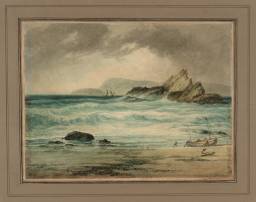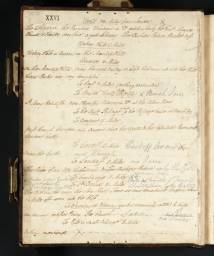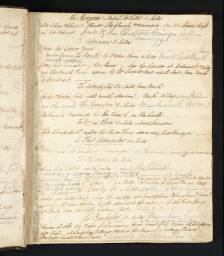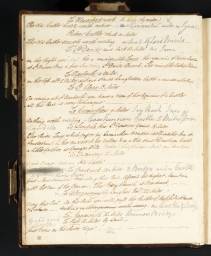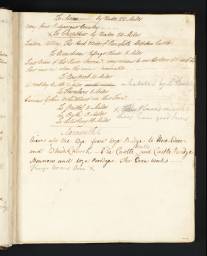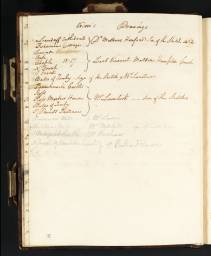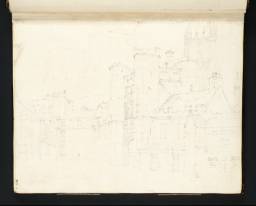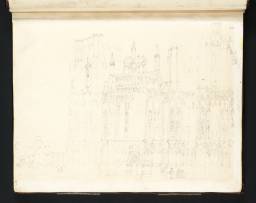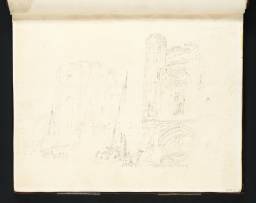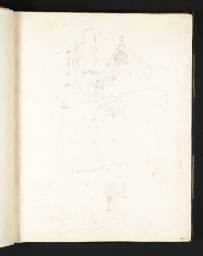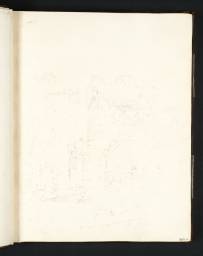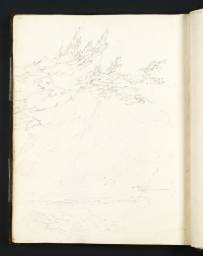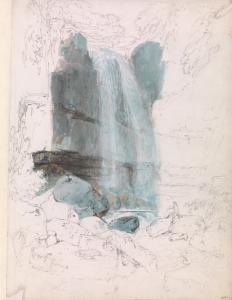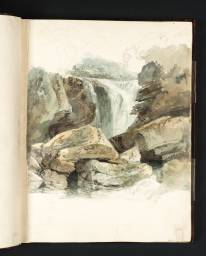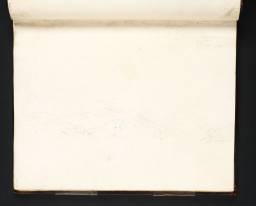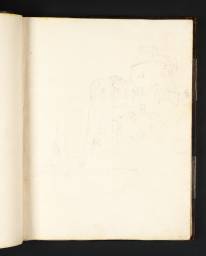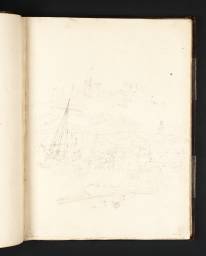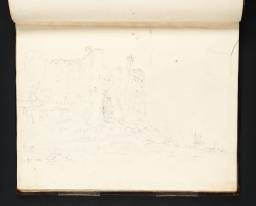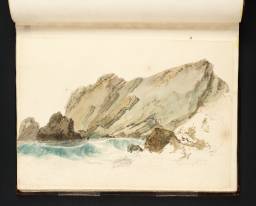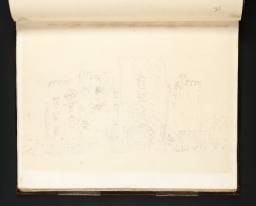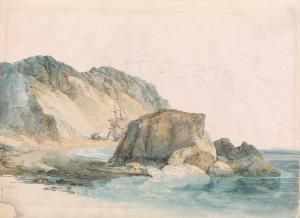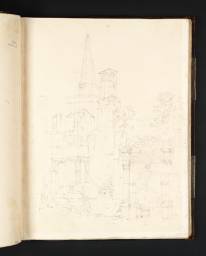Turner Bequest XXVI 1–41, 43–45, 47–56, 58–69, 71–79, 83, 85, 87–99
Sketchbook bound in calf with and gold tooled spine; four brass clasps (one now broken)
Label stamped in gold on red ‘SKETCHES’ on spine; Finberg records a ‘label on back’ (no longer extant) inscribed by Turner ‘South Wales-Mon’; spine inscribed by Turner in pen and ink ‘49’; front cover inscribed by Turner in pen and ink ‘[?Derbyshire] | Yorkshire | Durham | Northumberland | [?Tweed]’ descending vertically; compare similar inscription on cover of North of England sketchbook, Tate (Turner Bequest XXXIV), of slightly different dimensions
94 leaves of white wove paper edged in yellow; watermarks ‘J WHATMAN 1794’ and ‘E & P 1794’; page size approximately 264 x 203 mm
Numbered 176 as part of the Turner Schedule in 1854 and endorsed by the Executors of the Turner Bequest, George Jones, Charles Lock Eastlake and John Prescott Knight, in ink ‘No. 176 | Geo Jones’ top right and in pencil ‘C.L.E.’ | ‘JPK’ below on recto of third front flyleaf (opposite D40557); same page inscribed by Ralph Wornum in pencil ‘two out | R.W.W: | 1868’ and by A.M. Hind in pencil ‘No 29 mounted | A.M.H. 1933’ centre right; and stamped in black ‘XXVI’ bottom right
Inside back cover inscribed by Turner in pencil ‘Mr Thomas Edwards Carmarthen | Attorney’ top left, ascending vertically; stamped in black ‘XXVI’ top right
Label stamped in gold on red ‘SKETCHES’ on spine; Finberg records a ‘label on back’ (no longer extant) inscribed by Turner ‘South Wales-Mon’; spine inscribed by Turner in pen and ink ‘49’; front cover inscribed by Turner in pen and ink ‘[?Derbyshire] | Yorkshire | Durham | Northumberland | [?Tweed]’ descending vertically; compare similar inscription on cover of North of England sketchbook, Tate (Turner Bequest XXXIV), of slightly different dimensions
94 leaves of white wove paper edged in yellow; watermarks ‘J WHATMAN 1794’ and ‘E & P 1794’; page size approximately 264 x 203 mm
Numbered 176 as part of the Turner Schedule in 1854 and endorsed by the Executors of the Turner Bequest, George Jones, Charles Lock Eastlake and John Prescott Knight, in ink ‘No. 176 | Geo Jones’ top right and in pencil ‘C.L.E.’ | ‘JPK’ below on recto of third front flyleaf (opposite D40557); same page inscribed by Ralph Wornum in pencil ‘two out | R.W.W: | 1868’ and by A.M. Hind in pencil ‘No 29 mounted | A.M.H. 1933’ centre right; and stamped in black ‘XXVI’ bottom right
Inside back cover inscribed by Turner in pencil ‘Mr Thomas Edwards Carmarthen | Attorney’ top left, ascending vertically; stamped in black ‘XXVI’ top right
Accepted by the nation as part of the Turner Bequest 1856
Exhibition history
References
This is the larger of the two calf-bound sketchbooks that Turner took with him to South Wales in the summer of 1795. The sturdy binding, and the substantial size of the pages, were to prove a model for future expeditions and he continued to have his books made up in this way into the first decade of the next century. The book also begins with a detailed itinerary (D40553–D40556), copied into it by a clerk or secretary in the characteristic ‘secretary’s hand’.
In many of the drawings the pencil technique is notably more refined and intricate than anything he had produced before, designed to record as much detail as possible. Aerial perspective is conveyed by subtle variations in the weight of the line, calibrated according to the distance of objects from the eye. Several subjects partly finished in watercolour testify to Turner’s consciously training himself in the complexities of depicting water in motion, which was to be an important component of his first exhibited oil painting at the Academy the following year, Fishermen at Sea (Tate T01585).1 That picture also displayed his skill in painting effects of both moonlight and firelight, the topic of a colour study (Tate D00689; Turner Bequest XXVIII D) made on the basis of a drawing of Llanstephan Castle with a lime-kiln on folio 19 recto (D00571; Turner Bequest XXVI 18).
If the drawings are meticulous, the inscriptions are often correspondingly neat, written in a tiny hand that has become difficult to decipher, especially since the Tate flood of 1928. For some we are reliant on transcriptions made by Finberg before that event. When Finberg catalogued it, and reproduced some of its pages in the Walpole Society volumes for 1914 and 1918, the book was largely disbound and in poor repair:
The present condition of the book is a sad one. Nearly all the best drawings have been cut out of it. The process was begun in 1868, when Mr. Wornum ripped two sheets out.2 Then Mr. Ruskin borrowed the book for his Drawing School at Oxford, and cut out twenty-five of the pages, without making any record of their positions or relative order,3 and used the drawings for his pupils to copy. The smudges made by the clumsy fingers of these copyists do not add to the value or attractiveness of Turner’s drawings. Since Mr. Ruskin’s time, the work of depletion has been continued and at present the leaves of this book are scattered all over the country amongst the various loan collections made to provincial galleries. ... The only idea of the authorities who now have charge of them seems to be to scatter them as far apart as possible.4
Finberg renewed his attack on the treatment of this book in the second of his two articles about it, where he recounted the history of Tate D00582 (Turner Bequest XXVI 29), the view of St David’s Head from Porthsallie Bay, which Turner had removed and mounted; see the entry for that sheet.
Some leaves remained unused after the Welsh tour, and Turner took the book with him on a tour of Kent in April–May 1798, when he stayed with the Rev. Robert Nixon at the Parsonage, Foot’s Cray; the drawings on folios 68 recto to 79 verso (D00627–D00649; Turner Bequest XXVI 71– 87v), and 84 recto to 88 recto and 90 recto (D00654–D00658, D00660; Turner Bequest XXVI 92–96, 98) pertain to that visit5 (see Tate D00878; Turner Bequest XXXIII G). Folios 83 recto and 89 recto (D00653, D00659; Turner Bequest XXVI 91, 97) belong with the earlier Welsh drawings. The book should perhaps be renamed South Wales and Kent.
In his Inventory of 1909 Finberg placed the South Wales tour after the tour to the Isle of Wight (see the Isle of Wight sketchbook, Tate; Turner Bequest XXIV), but by 1914 he had doubts about this,6 and when his biography of Turner was published in 1939 he confirmed a revised ordering of the tours, citing as evidence the engraving of Swansea7 published in the Pocket Magazine, 1 September 1795. He accordingly suggested that the South Wales tour took place in June–July, and the Isle of Wight tour in ‘August or September’.8
Martin Butlin and Evelyn Joll, The Paintings of J.M.W. Turner, revised ed., New Haven and London 1984, pp.1–2 no.1, pl.1 (colour).
Technical notes
How to cite
Andrew Wilton, ‘South Wales Sketchbook c.1795–8’, sketchbook, April 2012, in David Blayney Brown (ed.), J.M.W. Turner: Sketchbooks, Drawings and Watercolours, Tate Research Publication, December 2012, https://www

